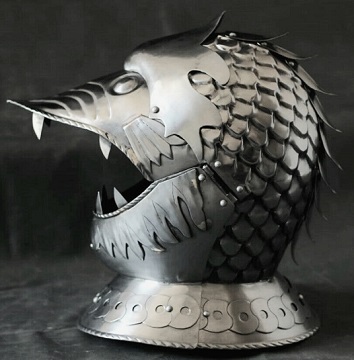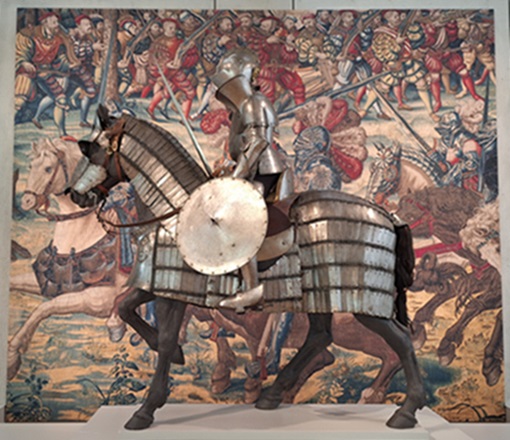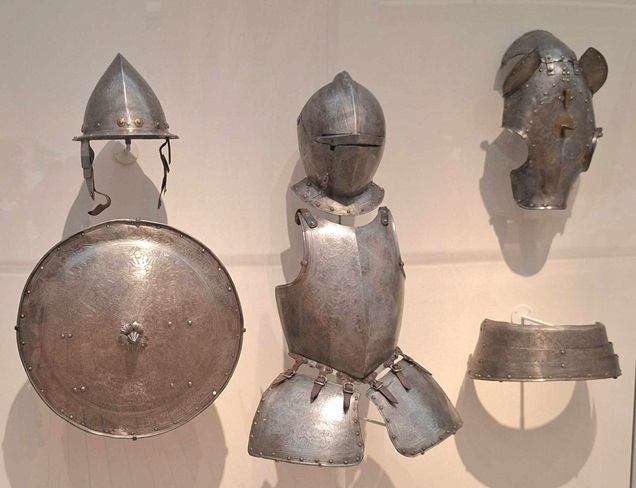Subject: cavaliere knight
Culture: Renaissance Italian
Setting: Italy 16thc
Object: armatura armor
Arlington Museum of Art > A Knight's Tale *
"Suit of Armor Italian manufacture (Lombardy)
ca. 1540-1550 Steel, wood, leather, linen, silk
This type of armor, constructed by horizontal lames (or laminae), is also referred to as anime.
The name is derived from old breastplates articulated in the same way that were worn under a leather doublet or jacket during the 1300s
-- a type of predecessor to the modern bulletproof vest. The mobility of the prototype was completely lost in the models of the 1500s.
All of the lames were riveted together, impeding almost any movement by the wearer."
* National Gallery of Art > West Building
"PROBABLY MILANESE
'The Morosini Helmet' (visored burgonet)
probably 1550/1560
iron or steel, repoussé, embossed, with gilding and silvering" .,,
* National Gallery of Art > West Building
"GIOVANNI PAOLO NEGROLI Milanese, active 1525/1565
Helmet (burgonet) in the Form of a Dolphin Mask
1540/1545 iron or steel, repoussé, embossed, and chiseled" ...
Global Nautical *
* Museum at the Fashion Institute of Technology > Love and War: The Weaponized Woman
Metropolitan Museum of Art > Stone Gallery of Arms & Armor *
"Armor of Giovanni Battista del Monte
Steel, etched and partly gilt Italian (possibly Brescia), about 1590
Del Monte (1521-1614) was a mercenary soldier who at various times served the emperor, the pope, the kings of Spain and France, and the Venetian Republic. This armor dates from del Monte's service to Venice as captain general of infantry and was probably made in Brescia, an armormaking center then under Venetian control.
* Mabee-Gerrer Museum of Art > Permanent Collections
Much of what we know about this armor comes from three inscriptions that tell us who made it, when it was made, and where it was made. If you look on the upper right corner of the shield you can find one of them hidden in the midst of other engravings.
Kimbell Art Museum > Art & War in the Renaissance: The Battle of Pavia Tapestries *
"Brescia Knight on Horseback in Tournament Armor with Thrusting Sword c. 1550-1570 Steel, wood, leather, and cloth ...
This tournament armor was produced in the northern Italian city of Brescia. The decoration includes an unusual motif of gilded whorls that extend over the entirety of the armor's surfaces. Variations and chiseled finishes can be seen on the crest of the rider's helmet and at the neckline, as well as on the horse's headpiece, tail attachment, and breastplate. In the center of the breastplate is a worn engraving depicting St. George slaying the dragon. This suggests a Sicilian provenance -- from the Bonanno-Branciforte armory -- where the Compagnia dei Cavalieri Giostranti,
stationed in Palermo, held St. George to be their patron saint.
"The barding (protective horse armor) is made of rectangular lamellae spliced together with chains of ring mesh in a 'barley grain' style similar to that of typical Ottoman trappings, though their plates ran horizontally."
* Hermitage > Pйцaрский Эaл
Kimbell Art Museum > Art & War in the Renaissance: The Battle of Pavia Tapestries *
"POMPEO DELLA CESA (Italian, c. 1537-1610) Components of an Armor Garniture Early 17th century Burnished steel ...
A garniture is a complete suit of armor composed of exchangeable parts adaptable for equestrian, tournament, or infantry use. The components of this garniture were made for Ranuccio Farnese (1569-1622), son of Alessandro Farnese (1545-1592). It was probably one of the last works completed by the renowned Milanese armorer Pompeo della Cesa (c. 1537-1610) before his death. The decoration is spread over the entire surface with a phytomorphic (plant form) lattice engraving with a rhomboidal pattern, featuring trophies of Farnese family arms and heroic figures. A church is engraved on the buckler shield -- referring to the surname 'della Cesa' (of the Church)."



